What happens to cloud computing prices in recent years
- Transfer
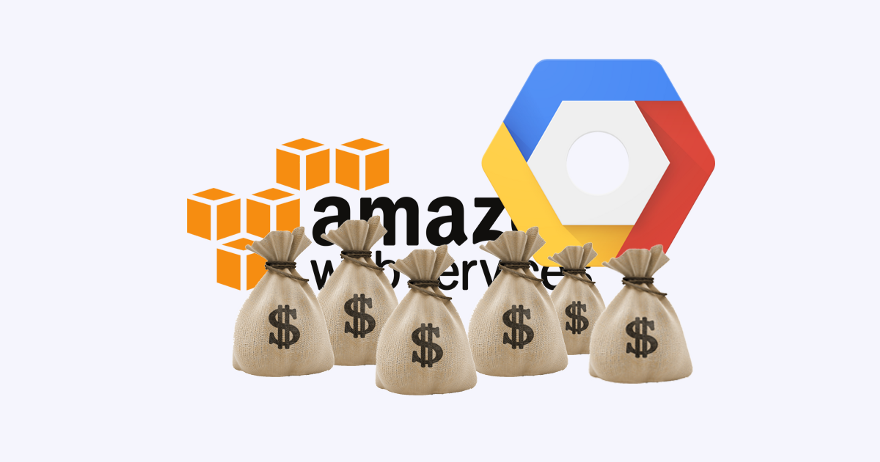
I noticed that in Silicon Valley a lot of noise on the subject of falling prices for cloud computing. Entrepreneurs, venture capitalists, and the media are writing about this trend, arguing that it has allowed a new wave of startups to emerge in areas such as artificial intelligence and large-scale data processing. Many articles argue that new technologies and high competition over the past few years have dramatically reduced the cost of clouds.
An example from Natan Benaitch, vice president of Point Nine Capital:
I believe that artificial intelligence is one of the most promising and progressive possibilities of our time. There are several reasons why this is so ... TheJohn Melas-Kiriazi, Spark Capital investor, reiterates this view:
cost of computation and storage falls by an order of magnitude , and the computational ability of modern processors is growing.
Machine learning (ML) and some forms of artificial intelligence (AI) officially became mainstream. The explosion of innovation, which we see in AI / ML, is associated with a number of technological advances that have emerged over the past few decades: faster and cheaper computers (according to Moore's law), cloud computing at variable costs ...Many refer to Moore's Law as the cause of the “order of magnitude” of improvements in cloud pricing. Others go even further and create their own theories. For example, the Bezos Act, proposed by Greg O'Connor (CEO AppZero) in the form of the idea that "in the entire history of a cloud, the price of a unit of computing power is reduced by 50 percent approximately every three years."
It is clear that many bright minds are optimistic about the rapid decline in the cost of cloud computing and the subsequent growth of innovative startups that can rise on this wave.
But are cloud prices really falling?
I often asked this question because I am the founder of a startup that uses cloud storage and data processing in its work. After an expensive month in the cloud, I wanted to confirm this trend by reviewing historical data.
Since the offers of cloud providers are so diverse, there can be many different ways to measure changes in value. However, for most there are two main areas: computing and storage. I went to the online archive to find out if the prices for these cloud services had really plummeted and found that the trends are not as obvious as many say.

The Wayback Machine - Internet Archive Web Service. The content of web pages is fixed from time to time with the help of a bot or when the site visitor manually specifies the address of the page to be fixed. Thus, you can see how this or that page looked before, even if it no longer exists.
Price trends for the period 2014-2018.
I looked at the Google Cloud Platform prices for Compute Engine (Google Virtual Machines) and Cloud Storage, as well as their competitors AWS EC2 and, accordingly, AWS S3. I used the online archive to compare prices until 2014.
Virtual machines
Below are the prices for the Compute Engine on the GCP as of January 3, 2018 (note of the translator: as of June 13, the prices have not changed) :
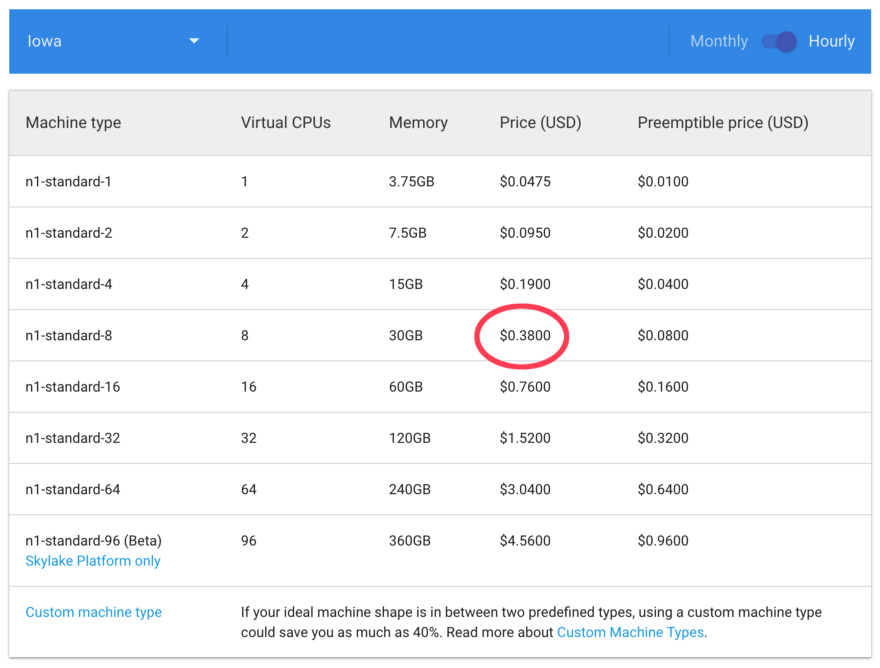
For comparison, I focused on the standard n1-standard-8 instance at a price of $ 0.38 / hour. Please note that as of 2018, these prices are dependent on the location of the server - this screen shot is in the default area (Iowa), which is usually cheaper than others.
I compared these prices with those over the past two years. January 12, 2017:
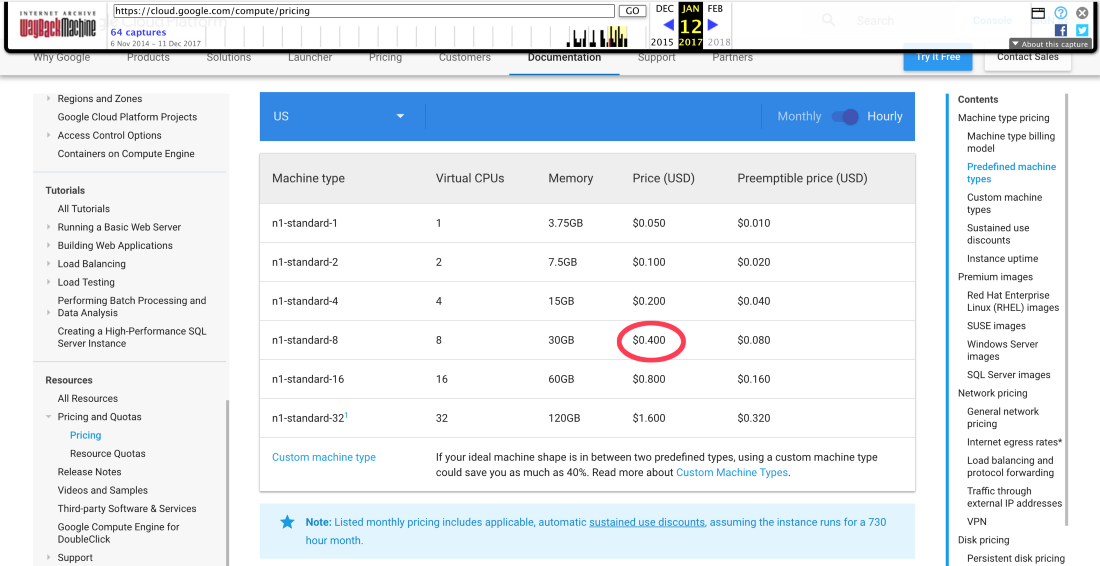
And January 23, 2016: The
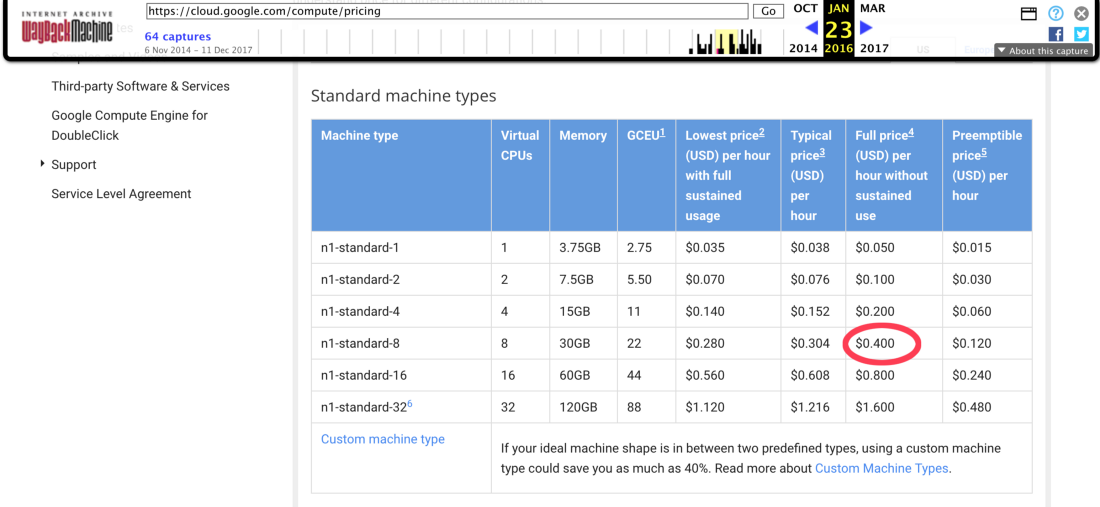
price for the same n1-standard-8 was $ 0.40 per hour two years ago. The fall in prices by 5% in two years is hardly an order of magnitude better.Current virtual machine prices in Northern Virginia have actually become even higher ($ 0.425).
In March 2015, the same VM cost .504 US dollars:
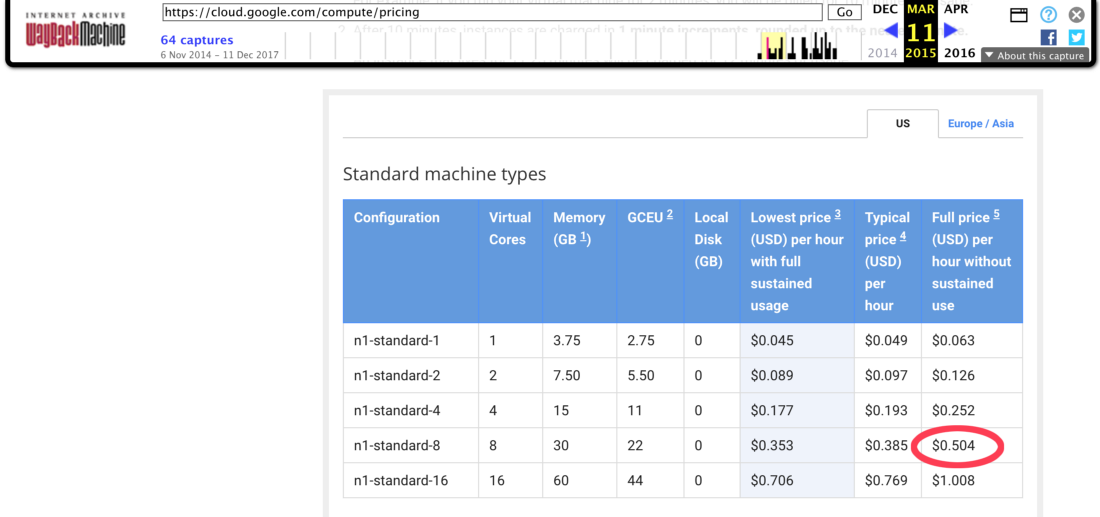
The same price in November 2014. This is the earliest picture I could find in the Archive:
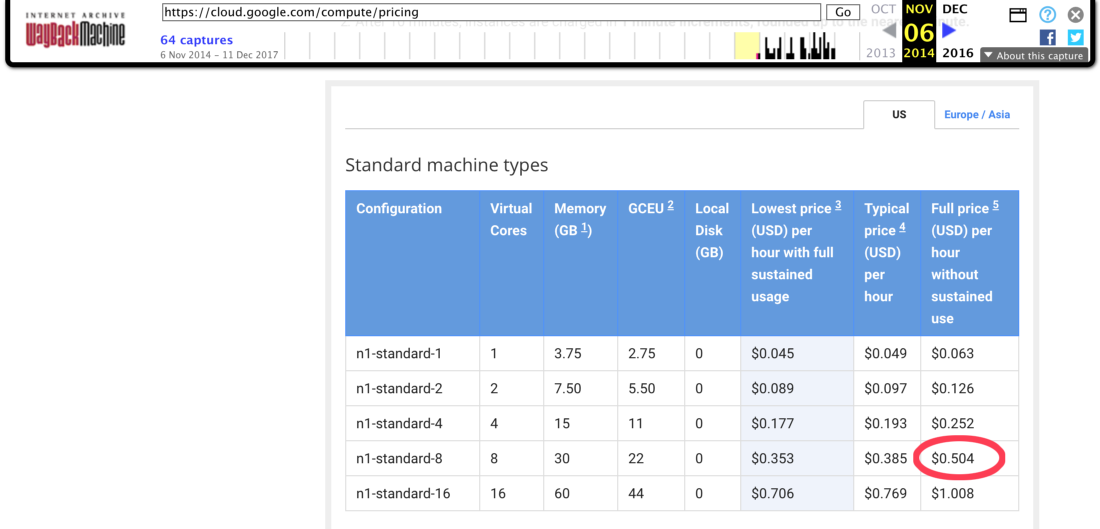
Thus, the prices for Google Compute Engine fell by 20% for the period 2014-2016 and by 5% from 2016 to 2018. In some places, the costs of Google Compute Engine have not decreased over the past two years. There is a decline, but one cannot say that "prices have collapsed."
Storage
If the cost of a unit of computing power does not fall by an order of magnitude, then perhaps some excitement is associated with a falling price for data storage. A drastic reduction in storage costs (and the associated data transfer) would allow small companies to analyze large data sets and transfer more data to the cloud.
The cost of storage in the cloud is divided into two main articles: per GB of storage or for the space occupied by files and for transferring over the network or, in fact, for downloading files. As with computing power, there are several nuances that can cause price changes, such as the physical location of stored files. If we look at the standard price in Google Cloud Storage for today, we see that the storage cost is about $ 0.026 per GB:
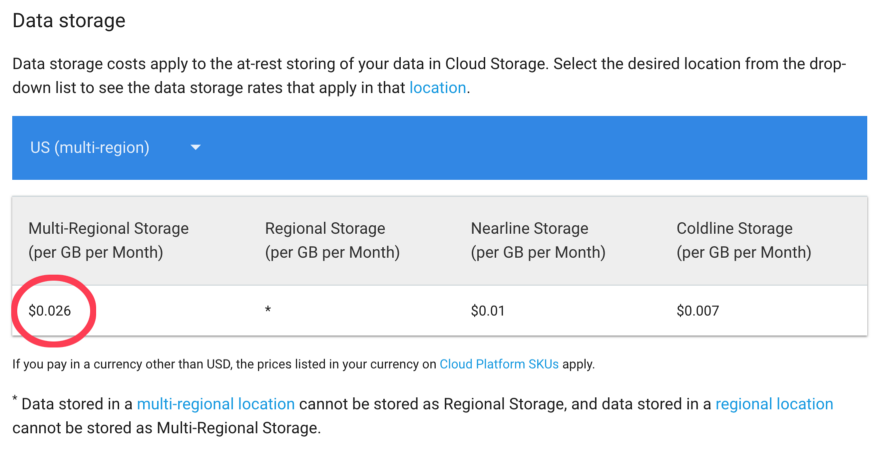
Data transfer costs start at $ 0.12 per GB up to 1 TB:
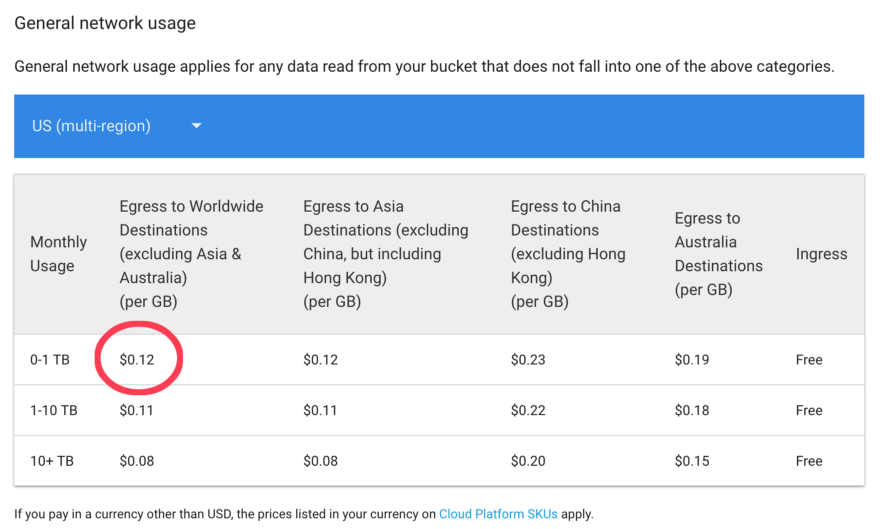
Using the online archive, we can compare today's prices with December 2014.
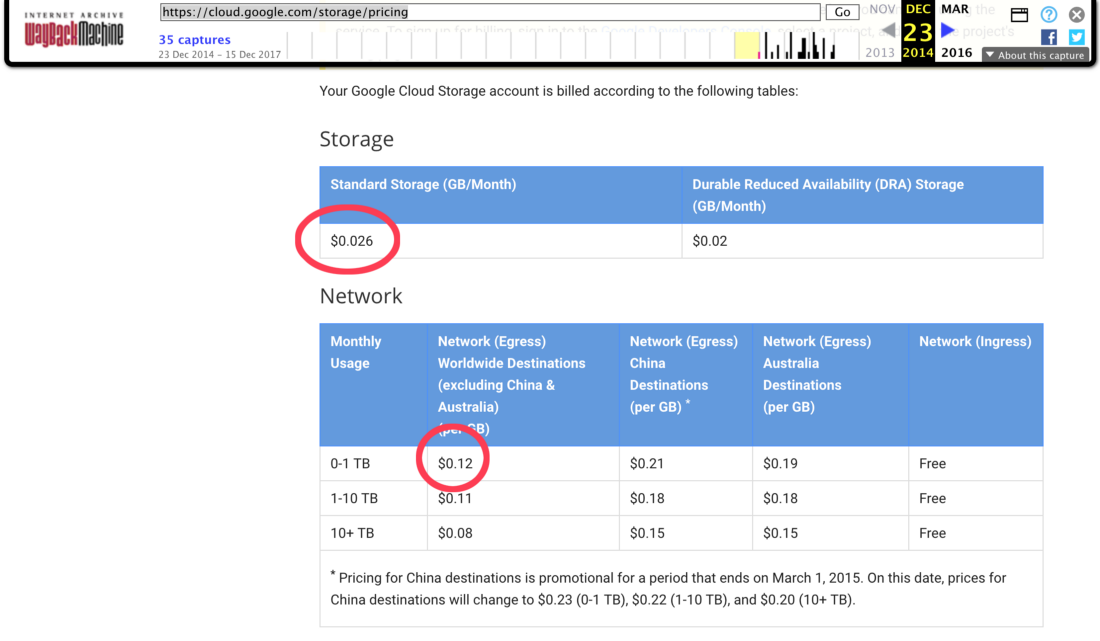
Surprisingly, the basic costs of Google’s cloud storage have not changed at all, starting from the earliest snapshot available in the online archive, about 4 years ago. If your startup is counting on a "collapse in cloud prices", you have not been lucky for the past 4 years.
How about AWS and other cloud computing providers?
In this article, I decided to start analyzing with Google Cloud for the sake of accuracy. Google Cloud's pricing pages are clearer. AWS pricing pages are much more detailed and do not show prices so clearly. But if we browse the AWS News blog in search of articles on price cuts for AWS instances, we’ll notice that the last price cuts in the US were noted in November 2016. This means that AWS did not reduce the price of cloud services in the United States for all and for all in 2017. In November 2016, only Northern Virginia VMs took part in price reductions. Even in this particular region, price cuts corresponded to what we see in Google Cloud - about 5%. This is unlikely to fall on the order, which many expected.
A full analysis of the prices of other major cloud providers is beyond the scope of this article, but a superficial observation of cloud service providers in the US shows a similar trend (or lack thereof). For example, if we look at the current Digital Ocean tariff plans, we will see that their standard plan with 2 GB of RAM, 2 cores, a 40 GB SSD module and a 3TB limit on data transfer costs $ 20 per month.
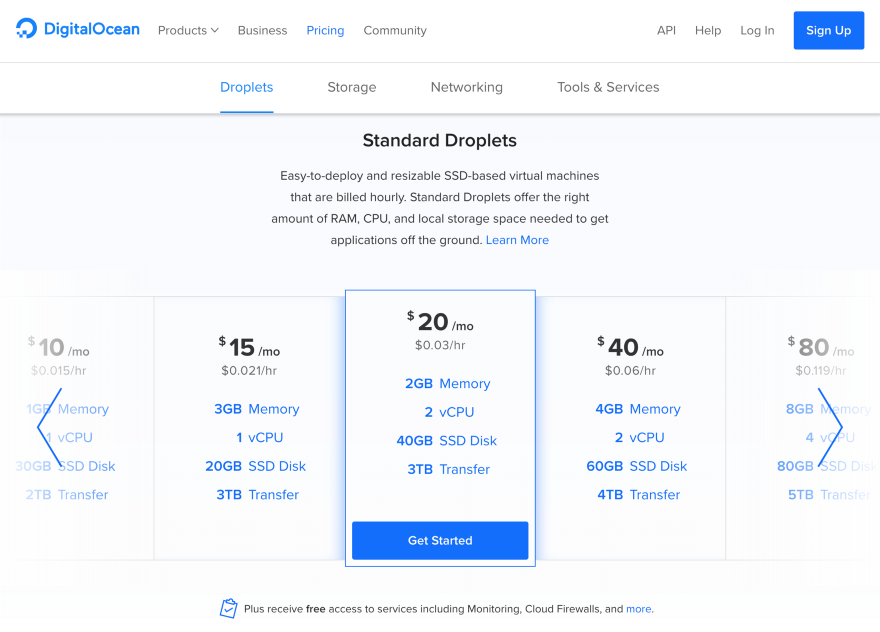
Now we can compare this with their prices in January 2014.
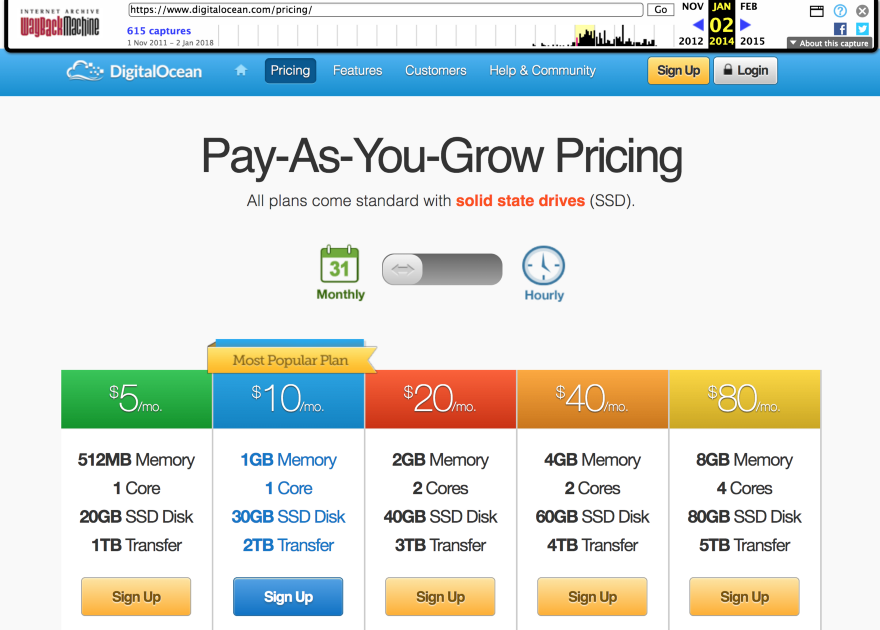
You can see that by paying $ 20 per month in 2014, you will receive the same cloud settings as today. At Digital Ocean, the value of clouds has not declined over the past four years. Many leading cloud computing providers have such “solid” prices.
Effects
The development of artificial intelligence technologies is undoubtedly an important trend, but the idea that new companies in this area will appear as a result of lowering the cost of clouds does not find support in analyzing data.
However, we can find evidence that startups that bet on the price reduction trend are in trouble. At the beginning of the year, the popular video sharing platform, Vidme, closed, citing an inability to build a sustainable business.
Storing and delivering video is becoming less expensive, but remains extremely expensive ... When we started in 2014, we predicted that infrastructure costs would decrease due to increased competition in the CDN and data storage business. Although prices have fallen over the past few years, our total costs still outpaced our ability to generate revenue.
Cloud prices in Russia. Comment Cloud4Y
Background: Cloud Cloud4Y built on VMware virtualization technology stack with support for all cluster options (HA, DRS, vMotion), and corresponds to the concept of software defined data center (SDDC). Tenants can create their own virtual data center (vDC) and at any time change the configuration of virtual machines, networks and storage in the shortest possible time using a single and convenient control panel vCloud Director 9.0, paying for services upon consumption.
For price analysis, we used a similar method. Below is one of the very first images found in the Internet archive. The price for the practically minimal configuration today in 2012 was 2220 rubles without discounts.
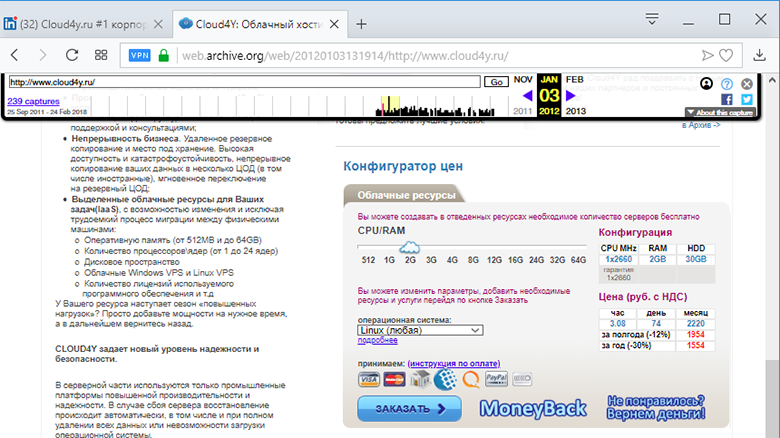
As of June 13, 2018, the price per configuration: 1 CPU, 2 GB RAM (100% allocated resources) and 30 GB HDD, a guaranteed unlimited channel of 5 Mbps and 14 backup points in a geographically remote data center, excluding discounts, will be 1975 rubles.
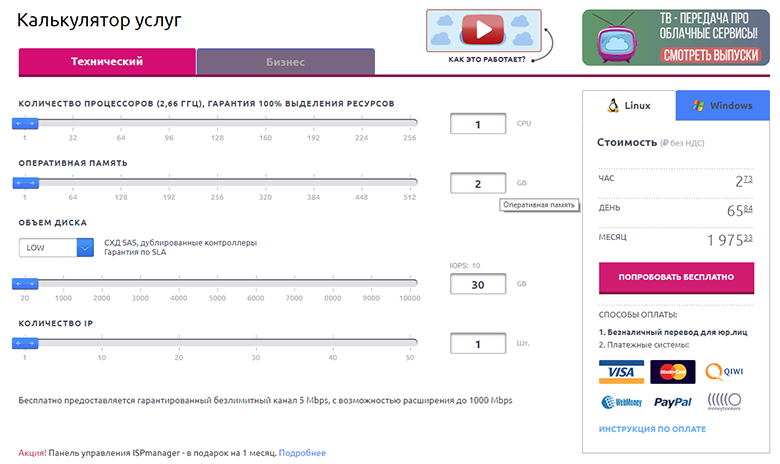
It is worth noting that the calculator works based on the assumption of using the VM in the 24x7x30 mode. When you do not use a virtual machine - no fee is charged. Using an instance in 12x5x30 mode, the cost of the service for you may be lower by more than 60%.
Thus, the price reduction in rubles in the period from 2012 to 2018 amounted to 11.4%. It is also worth noting that
- The average annual exchange rate of the Central Bank in 2012 is 31.0742 rubles for 1 US dollar, and today it is 63.1164 or more than two times more.
- The inflation rate between the beginning of 2013 and the beginning of 2018 was 45%:
Cloud computing is one of the few examples when the cost of services in Russia is really falling. In addition, to support domestic teams, we have a special offer. If your company is developing and wants to get a virtual cloud server (IaaS) service with a 40% discount, just fill out a small form and enter the promotional code: " developer40 ". The offer can be used by any company registered in the Russian Federation, the main activity of which falls under the category “Software development and consulting in this area”.
